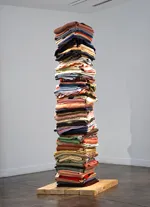
link: http://www.pem.org/press/press_release/212-pem_announces_bold_new_exhib…
PEM ANNOUNCES BOLD, NEW EXHIBITION OF NATIVE ART....
Shapeshifting: Transformations in Native American ArtOn view January 14 through April 29, 2012 ----- This winter, the Peabody Essex Museum (PEM) presents, Shapeshifting, one of the largest Native American Art exhibitions to open in North America in more than 30 years. Nearly 80 works from public and private collections worldwide offer a far-reaching exploration of Native American art as a continuum, juxtaposing historic and contemporary artworks. Through constellations of objects created in a range of media - sculpture, painting, ceramics, textiles, photography, drawing, film, video and monumental installation - visual and conceptual connections are drawn between generations of Native people, art traditions and cultures. "Typically arranged chronologically, geographically, or by medium, exhibitions of Native Art have almost exclusively focused on either historical or contemporary works, with very little mixing of the two," says Karen Kramer Russell, exhibition curator and PEM's curator of Native American Art and Culture. "Shapeshifting will prompt visitors to see the links and continuities within the vast panorama of Native American art, and to consider it with fresh eyes. Our intention is to shift how Native Art is exhibited and discussed." Spanning vast cultural, historical, intellectual, and aesthetic terrain, Shapeshifting offers a new approach to Native American art by exploring the conceptual underpinnings and artistic intent of contemporary and historic artworks alike."We have been especially fortunate to have the wise counsel, creativity, and expertise of a stellar group of advisors, authors, and artists from a wide range of disciplines and experiences, including many from Native American and other cultures," said Lynda Roscoe Hartigan, The James B. and Mary Lou Hawkes Chief Curator at PEM. Shapeshifting is organized into four thematic sections: Changing, Knowing, Locating, and Voicing. Two monumental contemporary installations that compellingly address familiar icons and materials-Kent Monkman's 2007 Théâtre de Cristal and Brian Jungen's 2002 Cetology-begin and end visitors' journey through the exhibition.CHANGING | Expanding the imaginationNative artists have continuously embraced innovation, adapting new ideas and expanding their means of expression. Nicholas Galanin's 2006 video work, Tsu Heidei Shugaxtutaan (We Will Again Open This Container of Wisdom That Has Been Left in Our Care), powerfully conveys the artist's ability to overlay his experiences as a Native American in contemporary society with the cultural traditions of his Tlingit and Aleut ancestry. His two-part video begins with a non-Native break dancer in an empty industrial space performing modern dance moves to the chant and drum of a traditional Tlingit song. The second portion is a perfect inversion: a Tlingit dancer in full ceremonial garb performs a traditional dance to the beat of electro-bass techno against the backdrop of Tlingit carving motifs.KNOWING | Expressing worldviewThe second gallery illustrates the strikingly different ways in which artists imagine, understand and express their experience in the world, especially as influenced by culture and unique personal vision. It is intended to counter the perception that Native people share a single monolithic worldview.The upper portion of a Yup'ik ceremonial mask from the early 1900s depicts walaunuk, the movement of bubbles rising to the surface of water. Among the Yup'ik of Alaska, bubbles are considered to be visible manifestations of breath and underwater life. A seal, for example, must willingly give up its life to a hunter and, when doing so, the animal's soul retreats to its bladder. In reciprocity for this sacrifice, Yup'ik men inflate seal bladders during a five-day winter festival. At the close of the festival, the seal bladders are deflated under the ice, returning the animal's spirit back to the water.LOCATING | Exploring identity and placeAs in many cultures, the haunting question of 'where is home?' is undeniably formative. The third section of the exhibition considers the importance of family, community, land, and place in the cultivation of Native individual and tribal identity. Kevin Pourier's 2008 Sitting Bull Spoon revives the creative use of buffalo horn by 19th-century Lakota people. While wild buffalo populations have been largely decimated and few contemporary artists work in this medium, Pourier has taken the traditional practice of buffalo horn carving and has created something quite modern. An image of the legendary Hunkpapa Lakota leader, Sitting Bull, is painstaking rendered by incising, buffing, and inlaying minerals. Sitting Bull's signature monarch butterfly is shown fastened to his hat, while the motif flutters across the surface of the horn in bas-relief. For Lakota artist Pourier, the image of Sitting Bull represents Lakota strength and cultural endurance, while butterflies symbolize love and family.VOICING | Engaging the individualThe fourth thematic section of the exhibition focuses on the artist as an individual engaged in the process of self-expression while interacting with the rest of the world. Luiseño artist Fritz Scholder (1937-2005) has been called "the most influential, prolific, and controversial figures in the history of Native art."¹ Through his Super Indians series which he started in 1967, Scholder provided a dramatic counterpoint to the prevailing romantic depictions of Native life. Scholder depicts a Plains warrior wearing stereotypical Native American garb but renders the work in a Pop art color palate dominated by citrus and bubblegum tones in brushstrokes influenced by one of his teachers, painter, Wayne Thiebaud. Far from a placid sunset-infused portrait, this image is fueled by the political radicalism of the 1960s, brimming with energy and immediacy that can barely be contained by the picture frame.OPENING DAY CELEBRATION | SATURDAY, JANUARY 14, 2012 | 10 AM - 5PMCelebrate the opening of Shapeshifting: Transformations in Native American Art with a day of performances, panel discussions, film, art activities, exhibition tours, and more. Details available at: www.pem.org/calendar